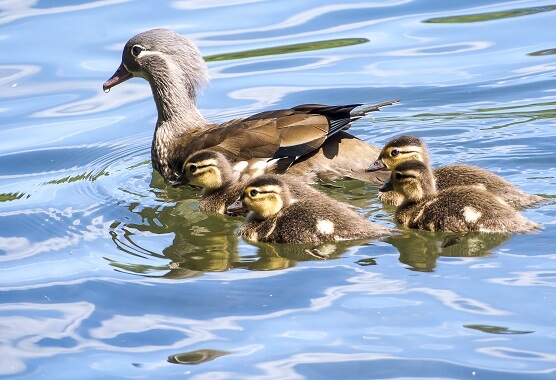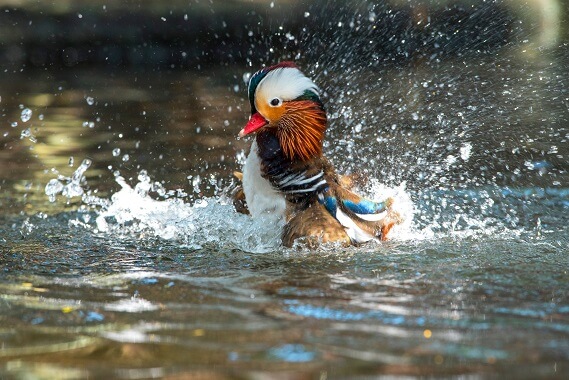
The mandarin duck (Aix galericulata), called yuan-yang by the Chinese, is a beautiful bird that is native to China, Japan, and Siberia. It is a close relative of the North American wood duck. Like most ducks, the male is much more colorful than the female and has quite striking plumage. The male has a white crescent above his eye and a red/orange face with whiskers. His bill is red. The rest of his plumage is red, orange, brown, green, and purple in color. During the breeding season, the males also have a sail of feathers over their backs. In contrast, females have grey and brown feathers and a light bill that has a tinge of pink. The female also has a white eye-ring. These birds inhabit pools, lakes, rivers, fast-flowing streams, marshes, and swamps surrounded by dense deciduous forest. Mandarin ducks originate from the Far East, where they are found in eastern Siberia, northeastern China, South Korea, and Japan. Some birds winter in southeastern China and Taiwan. These birds have been introduced to parts of the US, including North Carolina and California. They were also introduced to the UK, where there are approximately 1000 mating pairs. Mandarin ducks are highly social animals. They mate in pairs that form bonds for a season or more and sometimes will overwinter in flocks. Mandarin ducks have a very elaborate courtship. They form pairs at the beginning of the mating season and then start to look for a nest. The male will accompany the female on this nest hunt. The ducks build their nests in a hole in a tree, which can be up to 32.8 feet (10 meters) above the ground. The female lays between nine and twelve eggs. Incubation lasts approximately four weeks, and the eggs all hatch within a few hours of each other. The mother will coax them out of the nest by calling to them from the ground. The chicks will free fall to the ground from the nest before the move to feeding grounds. Surprisingly the chicks generally make this journey unscathed. At around 45 days post-hatch, the chicks are ready to fledge and will fly off to join another flock. The main threat to mandarin duck populations is habitat destruction. They are also prey for raccoons, minks, eagles, snakes, and otters. The Mandarin duck is considered as one of the most beautiful duck species due to its fascinating plumage. It is also a symbol and love and fidelity in China, Japan, and Korea as it often forms long bonds with its partner. Mandarin ducks are known to pair up for several breeding seasons, and in some cases, it has been reported that these bonds last for life. Aside from these features, these ducks are also examples of some other amazing biological concepts. Let’s take a closer look. In humans and many other animal species, sex is determined by the presence of specific chromosomes. Humans have an XY system, where a pair of chromosomes determines the sex of an individual. Females typically have two of the same kind of chromosomes (XX), and males have two different types of sex chromosomes (XY). Like most birds, mandarin ducks have a ZW sex-determination system, which is different from the XY system observed in most mammals. In the ZW system, females are the ones that have two kinds of sex chromosomes (ZW), and males have two that are similar (ZZ). This means that in this system, it is the female’s gametes, or eggs, that decides the sex of the offspring, and not the male’s sperm like in the XY system. The ZW system of sex-determination is relatively widespread in nature. Researchers have demonstrated that the ZW system decides the sex of the offspring of several species of fish, crustaceans, and some insects such as moths and butterflies. While the male duck stays around for the incubation period, once the eggs have hatched, he leaves the female to rear the chicks. During this time, he molts and sheds his colorful plumage. The male also sheds his primary flight feathers during this time and so he is unable to fly. With his bright plumage gone, the male is brown and grey in color like the female, which helps him blend in with his environment and hide from possible predators. There are eight genera and 50 – 60 species of dabbling ducks, including the mandarin duck. These ducks are named after the way they feed, but there are several differences between these ducks and other duck species. Dabbling ducks are usually found in shallow waters, such as flooded fields and marshes. They feed by tipping up in the water, with their head down and their rear end out of the water instead of diving. The word dabbling refers to how they feed, which is by moving their bill around in the water. They have flat, broadbills and float high on the surface of the water. This is an efficient way for them to feed on small insects that live on the surface of the water and to forage through floating algae and plants. Dabbling ducks legs are more central than diving duck species, which helps them to walk well on land where they may also graze. Unlike diving ducks, they are strong fliers and can take flight straight from the water.
Kingdom
Animalia
Phylum
Chordata
Class
Aves
Order
Anseriformes
Family
Anatidae
Genus
Aix
Species
Aix galericulata
Length
8 – 10 inches ( 21.0 to 24.5 cm)
Weight
1 – 3 pounds
Lifespan
Up to 12 years
Social Structure
Social
Status
Least Concern
Preferred Habitat
Wooded, rocky ponds and streams
Average Clutch size
9 – 12 eggs
Main food item
Seeds, acorns, small fruit, insects, snails, and small fish.
Main predators
Snakes and otters
The Basics

Fun Facts about the Mandarin Duck!
ZW Sex-Determination System

Males Molt after Breeding

Dabbling Ducks
